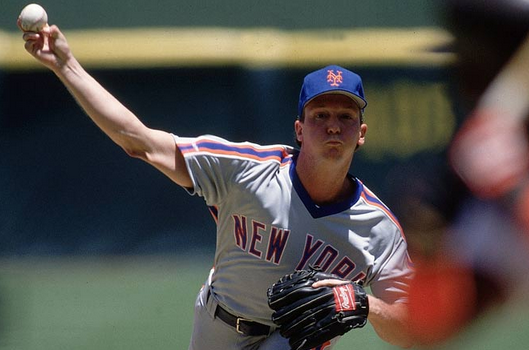
On February 13, 2003, the Mets coaxed pitcher David Cone out of retirement for one more go-round with the team.
Cone had retired after pitching for the Red Sox in 2001, missing the entire 2002 season. In 2003, Cone made four starts for the Mets, posting a 1-3 record with a 6.50 ERA. He retired in late May, citing a chronic hip problem as his reason for stepping away from the game as an active player, this time permanently.
The Mets originally acquired Cone from the Kansas City Royals prior to the 1987 season, in a deal for catcher Ed Hearn, and pitchers Rick Anderson and Mauro Gozzo. Cone was a Met from 1987 until August of 1992, when he was traded to the Blue Jays for Jeff Kent and Ryan Thompson.
In 1987, Cone had a record of 5-6 with a 3.71 ERA. Cone came into his own in 1988, when he began the season in the bullpen, and was moved to the rotation in early May. He finished the season, a year the Mets won the National League’s eastern division, with a 20-3 record and a 2.22 ERA. He placed third in the National League’s Cy Young award voting that season, and was selected to the All-Star team.
As the Mets moved to the NLCS against the Dodgers, Cone accepted a role with the New York Daily News as a commentator on the series. This may sound like a really bad idea, and it was. Cone at one point called Cy Young winner Orel Hershiser “lucky” for surviving eight innings against the Mets’ lineup, and also referred to Dodgers’ closer Jay Howell‘s curveball as “high school quality.”
Naturally, this served as an inspiration for the Dodgers, who shelled Cone in game two of the series for five runs in two innings. Cone would get a measure of revenge in game six, when he kept the Mets alive by pitching a complete game. The Mets would lose the series in seven games.
Overall in his first tenure with the Mets, Cone went 80-48. He led the National League in strikeouts in 1990 and 1991, with 233 and 241 respectively. In his last start of the 1991 season, Cone struck out 19 Phillies, tying Tom Seaver for the franchise single-game record. On August 27, 1992, with the Mets hopelessly behind the Pirates for the division lead, the team traded Cone to Toronto, ending his first tenure in Queens.
Cone was part of a World Series championship in Toronto 1992, and led the majors with 261 combined strikeouts with the Mets and Blue Jays. After the 1992 season, the Missouri native signed with the team that drafted him, the Kansas City Royals. He spent 1993 and 1994 in Kansas City, winning the Cy Young award in the strike-shortened 1994 season.
In April of 1995, the Royals traded Cone back to Toronto, who traded him to the Yankees in July of that season. He remained with the Yankees (re-signing with them twice) through the 2000 season, winning four titles with the Bronx Bombers.
Cone hit his individual career apex on July 18, 1999, when he threw a perfect game against the Montreal Expos on a sweltering day at Yankee Stadium. Cone was far less effective in 2000, his last year with the Yankees, with a 4-14 record and a 6.91 ERA. In the World Series against the Mets, Cone recorded a key out against Mike Piazza in game four. Piazza was the only batter Cone faced in that entire series.
Over his 17-year career, Cone logged a record of 194-126, with an ERA of 3.46, and ERA+ of 121, and a 1.256 WHIP. He struck out 2,668 batters in 2898.2 innings pitched, allowing 2.504 hits. He was a five-time all star, and had a career bWAR of 61.6.
Cone, who turned 58 years old in January, is currently a broadcaster with the Yankees, and can be heard doing color commentary with Paul O’Neill alongside Michael Kay.















